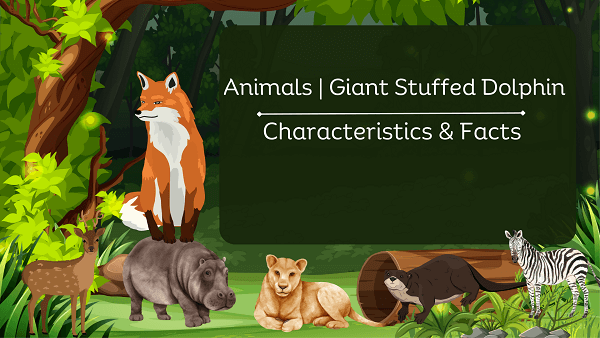Giant Stuffed Dolphin Definition | Characteristics & Facts
Home » Animals » Giant Stuffed Dolphin Definition | Characteristics & Facts
Giant Stuffed Dolphin Definition
Marine mammal that belongs to the family Delphinidae.
General Characteristics & Fact
Dolphins are highly intelligent marine mammals belonging to the cetacean family, which also includes whales and porpoises.
There are over 40 species of dolphins, with the most well-known being the bottlenose dolphin.
Dolphins are highly adapted for life in the water. They have streamlined bodies, a dorsal fin on their back, and flippers that aid in swimming. They are excellent swimmers and can reach speeds of up to 20 miles per hour (32 kilometers per hour).
Communication is an essential aspect of dolphin behavior. They use a combination of clicks, whistles, and body movements to communicate with each other, navigate, and find food.
They are carnivorous and feed on a variety of fish, squid, and crustaceans. Dolphins use echolocation, a process where they emit sound waves and listen for their echoes, to locate and capture prey.
Dolphins are known for their acrobatic displays, such as leaping out of the water, somersaults, and riding the bow waves created by boats.
These remarkable creatures have been studied extensively due to their intelligence and ability to learn. They have been known to exhibit problem-solving skills, tool use, and even display self-awareness.
Dolphins are highly regarded for their interaction with humans. They have been featured in various cultural traditions, folklore, and are often seen as symbols of intelligence, grace, and friendship.
Conservation efforts are crucial for the protection of dolphins as they face threats from pollution, habitat degradation, overfishing, and accidental entanglement in fishing gear. Many countries have established protected areas to safeguard these remarkable marine animals.
Read our Animals Encyclopedia with Complete Facts
Physical Characteristics of Giant Stuffed Dolphin
Dolphins, as marine mammals, possess a range of physical characteristics that enable them to thrive in their aquatic environment. Here are some key physical features of dolphins:
Body Shape: Giant stuffed Dolphins have a streamlined and elongated body shape that is well-suited for swimming through water with minimal resistance. Their bodies taper at both ends, with a slender snout or rostrum at the front and a powerful tail fluke at the rear.
Skin and Coloration: Giant stuffedDolphin skin is smooth, rubbery, and relatively hairless. Their skin is covered with a layer of blubber that helps with insulation and buoyancy.
Fins: Giant stuffed Dolphins possess several distinct fins that aid in their movement and balance in the water. They have pectoral fins located on the sides of their body, which they use for steering and stability.
Fluke and Tail: The tail of a dolphin is composed of two lobes known as the fluke. The fluke is horizontally oriented and acts as a powerful propulsion system.
Blowhole: Giant stuffed Dolphins possess a blowhole, which is an adaptation for breathing air at the water’s surface without fully exposing their body.
Teeth: Dolphins have sharp, conical teeth that vary in number depending on the species. They use their teeth for grasping and capturing prey.
Echolocation System: Dolphins have specialized adaptations for echolocation, a biological sonar system.
Continue To Explore All Animals That Start With D
Scientific Classification of Giant Stuffed Dolphin
Kingdom: Animalia (Animals)
Phylum: Chordata (Chordates)
Class: Mammalia (Mammals)
Order: Cetacea (Cetaceans)
Suborder: Odontoceti (Toothed whales)
Family: Delphinidae (Oceanic dolphin
Key Locations of Giant Stuffed Dolphin
- Coastal areas of North America
- The Mediterranean Sea
- The Caribbean Sea
- Coastal regions of South America
- Waters surrounding the United Kingdom
- The waters around Australia
- The Indian Ocean
- The waters around New Zealand
- Coastal areas of South Africa
- The Pacific Ocean
View All A-Z Animals List
Giant Stuffed Dolphin FAQs
What Does Giant Stuffed Dolphin Eat?
Dolphins primarily eat a diet consisting of fish and squid. They are skilled hunters, using teamwork and echolocation to locate and catch their prey. Some dolphin species may also consume crustaceans, small marine mammals, or other small marine organisms.
Explore More:
- Tarantula
- Mackerel
- Mackerel
- Sea Stars
- Bird
- Amphibians
- Vertebrates
- Sand Dollars
- Barnacles
- Scallop
- Brittle stars
- Tilapia
- Carp
- Krill
- Catfish
- Grouper
- Calm
- Yak
- Yucatan Brown Brocket
- White-tailed Deer
- Uakari
- Utahraptor (Dinosaur)
- Qinghai Lake Naked Carp
- Qilian Shrew
- Qinling Panda
- Qacha’s Nek long-fingered Frog
- Red Fox
- Red Panda
- Rockhopper Penguin
- Salamander
- Snail
- Storks
- Jacana
- Junglefowl
- Jabiru Stork
- Junco
- Japanese Crane
- Kudu
- Kingfisher
- Giant Stuffed Tiger
- Giant Stuffed Dolphin
- Giant Stuffed Bear
- Giant Stuffed Penguin
- Scrat (Ice Age)
- Freshwater Clams
- Water snakes
- Sphynx at
- Honeybees
- Parrots
- Caribou (also known as reindeer)
- Nemo (from Finding Nemo)
- Simba (from The Lion King)
- Pink Panther
- Garfield


